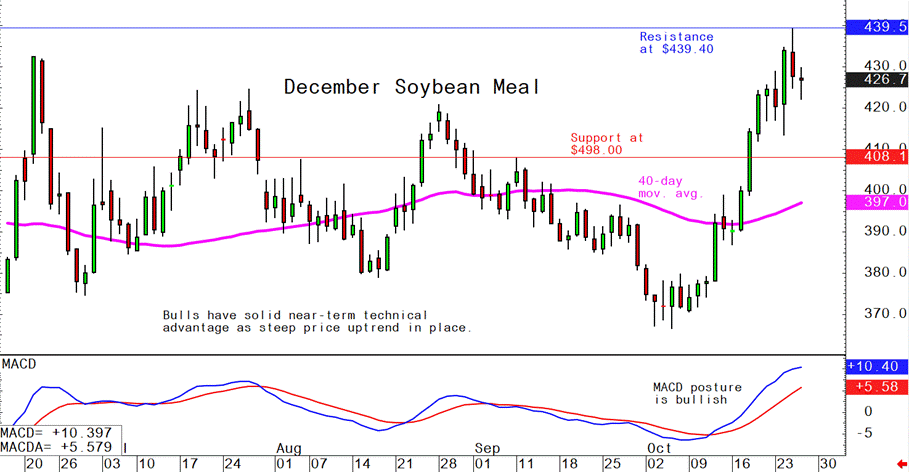



Pig outlook - Lean hog bears remain in solid technical control
Livestock analyst Jim Wyckoff shares pig news from around the globeThe lean hog futures bears continue to hold the solid near-term technical advantage as December hogs this week hit another new contract low and prices are in a five-week-old downtrend on the daily bar chart. That continues to suggest the path of least resistance for prices is sideways to lower for the near term. The latest CME lean hog index is down 26 cents at $78.41 (as of Oct. 24), extending the seasonal price decline. The recent sharp drop in live and feeder cattle futures prices has also emboldened the hog futures market bears. Lean hog futures bulls will have to produce multiple price closes above the $71.00 level in December futures to begin to suggest a market bottom is in place.
Weekly USDA US pork export sales
Pork: Net sales of 28,200 MT for 2023 were down 8 percent from the previous week and from the prior 4-week average. Increases were primarily for Mexico (10,200 MT, including decreases of 200 MT), China (3,400 MT, including decreases of 100 MT), Canada (3,200 MT, including decreases of 600 MT), Japan (2,900 MT, including decreases of 400 MT), and South Korea (2,600 MT, including decreases of 700 MT). Net sales of 400 MT for 2024 were primarily for Australia (200 MT) and South Korea (100 MT). Exports of 27,700 MT were up 7 percent from the previous week, but down 1 percent from the prior 4-week average. The destinations were primarily to Mexico (10,200 MT), Japan (3,500 MT), South Korea (3,000 MT), China (2,900 MT), and Colombia (2,200 MT).
USDA: US pork stocks remain well below average
USDA’s Cold Storage Report Wednesday afternoon showed frozen pork inventories totaled 462.8 million lbs., down 6.5 million lbs. (1.4%) from August, whereas the average over the past five years was a 3.0-million-lb. increase during September. Pork stocks fell 74.3 million lbs. (13.8%) from last year and were 69.4 million lbs. (13.0%) lower than the five-year average.
China’s hog numbers down from year-ago
China’s sow herd at the end of September totaled 42.4 million head, down 2.8% from last year, the ag ministry said. The pig herd dropped 0.4% to 44.23 million head.
China’s hog herd growing, putting pressure on prices
China’s hog production is still growing, a farm ministry official said, with a higher-than-normal number of breeding sows set to maintain downward pressure on prices. China had 42.4 million sows at the end of September, unchanged from the previous month, but 3.4% higher than the normal level, Chen Guanghua, head of the animal husbandry and veterinary bureau at the ag ministry said. “The level of pig losses may even be greater than that of the same period this year,” he said, urging farmers to adjust their production.
USDA sends final rule on livestock markets to OMB, aims to promote ‘inclusive competition’
USDA submitted a final rule titled "Inclusive Competition and Market Integrity Under the Packers and Stockyards Act" to the Office of Management and Budget (OMB). This rule encompasses "proposed revisions" to regulations under the Packers and Stockyards Act (PSA), with the objective of promoting inclusive competition and market integrity within the livestock, meats, poultry, and live poultry markets.
The final rule follows the publication of a notice of proposed rulemaking in 2022, which garnered multiple extensions for the comment period, concluding in January 2023. The Agricultural Marketing Service has clarified that the rule includes "supplemental amendments" aimed at defining conduct that USDA considers "unfair, preferential, unjustly discriminatory, or deceptive, and a violation of the PSA." It also seeks to clarify criteria and types of conduct that would be viewed as "unduly or unreasonably preferential, advantageous, prejudicial, or disadvantageous, and violations of the Act, including retaliatory practices that interfere with lawful communications, assertion of rights, and associational participation."
Notably, USDA has another final rule related to transparency in poultry grower contracting and tournaments currently under review at OMB. Despite scheduled meetings concluding by late September, it remains uncertain when either rule will be published, as the recently submitted rule was originally targeted for finalization in September.
WSJ: Chinese-owned pork producer Smithfield considers U.S. listing amid challenging industry conditions
Smithfield Foods, the largest pork producer in the United States, is reportedly in discussions about a potential return to the US stock market, the Wall Street Journal reports. The Chinese parent company of Smithfield, WH Group, is collaborating with banks to explore the possibility of taking the business public in the US once again, with the listing potentially occurring as early as next year. However, deliberations are ongoing, and the timing may change.
Smithfield Foods was acquired by China's top meat producer in 2013, resulting in its delisting from the New York Stock Exchange. Following the acquisition, the combined entity became the world's largest hog farmer and pork producer and went public in Hong Kong in 2014. Nonetheless, WH Group's shares have faced challenges and are currently trading near record lows, mainly due to an African swine fever outbreak in China in 2018, which significantly impacted hog herds. The US pork industry experienced growth in exports following the outbreak, but these exports have declined in recent years as China rebuilt its hog population, leading to an oversupply of pork in the US High livestock feed prices due to global events, such as Russia's invasion of Ukraine, have compounded challenges for the industry.
Smithfield's potential return to the US stock market comes amid concerns in Washington about Chinese ownership of key components of the US food supply chain. Smithfield CEO Shane Smith has defended the company's Chinese ownership, stating that it has helped boost sales.
Of note: While Smithfield's listing discussions are ongoing, other major meat companies, like Brazil's JBS, are also considering U.S. listings amid challenging conditions in the meat industry.
The next week’s likely high-low price trading ranges:
December lean hog futures--$64.00 to $70.00 and with a sideways-lower bias
December soybean meal futures--$415.00 to $450.00, and with a sideways-higher bias
December corn futures--$4.67 3/4 to $5.00 and a sideways bias
Latest analytical daily charts lean hog, soybean meal and corn futures










